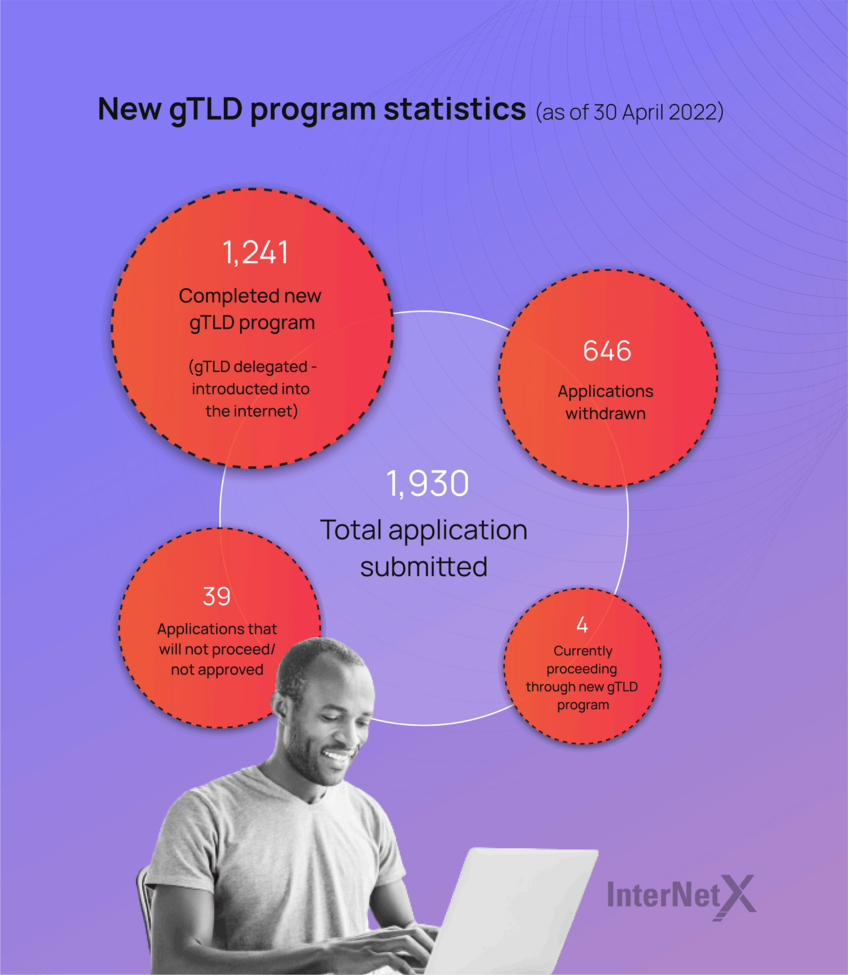
It’s all about domains… | Philippe Fouquart (GNSO | ICANN)

Can you imagine the internet without new gTLDs today? And the opportunities in the namespace are set to increase again! Philippe chairs the body which, among other missions, defines the policy of the new gTLD prgogram at ICANN. They are currently at work on the next round to offer more naming solutions for what we love most: Domains!
Published by

Simone Catania
Date
If we had to name one development that has disrupted the domain industry in the past few years, it would have to be the introduction of new gTLDs. Before 2012, if you wanted to register a domain name, you could choose between ccTLDs and a few gTLDs like .com or .net.
The first new gTLD application round was launched on 12 January 2012. Working behind the scenes is the Generic Names Supporting Organization (GNSO), a policy-development body responsible for developing and recommending policies on new gTLDs to the ICANN Board.
This organization achieved a tremendous accomplishment in creating the first applications and guidebooks. Now they are back at work, promoting innovation and competition on the internet even further.
Philippe Fouquart, engineer and Senior Expert in Naming, Numbering & Addressing at Orange, is the current Chair of the GNSO. His broad experience and expertise in the internet industry are now at the service of the GNSO, working towards their next ambitious and game-changing goal. They aim to finalize the policy for launching the second new gTLDs program. This is a historical change that we want to discuss with Philippe

Over two decades, I believe that ICANN has not only maintained and strengthened the endorsement of the technical enabler that is the DNS, but also and primarily its role as an oversight or coordination body using a unique multi stakeholder model, both from a technical and policy perspective.
1. You have devoted yourself to the internet throughout your career. How have you been engaged so far?
Over the last 20 years, I have been involved in technical and policy-related work in the internet technical governance and various international and regional organizations such as Standards Development Organizations (SDOs), specialized agencies of the United Nations, the International Telecommunication Union (ITU) and different industry groups. Today, I am an engineer and Senior Expert in Naming, Numbering and Addressing at Orange, a telecommunications operator based in France.
When it comes to ICANN, the first time I heard of it was through some colleagues who have participated since its inception. My company, named France Telecom at the time, was involved in the registry/registrar split trial in 1999, which almost coincided with the creation of ICANN. I have been extremely lucky to benefit from experienced people to guide me in this ecosystem during the early days of ICANN. In the past eight years, I started to become more involved at ICANN with the ISPs and Connectivity Providers Constituency within the GNSO and then as their representative on the GNSO Council for almost five years now.
In 2020, I was honored to be elected GNSO Chair. This is a rewarding and humbling responsibility. My term is shorter than some of the timelines we will be talking about here but the job essentially consists of helping to move forward pieces of work that were started long before I was appointed (and done by others!) and handing them over, hopefully with some progress, to those who will be in charge when they are completed.
Find perfect domains
2. How would you describe the work of the GNSO?
The structure and the mission of the Generic Names Supporting Organization (GNSO) and its Council are clearly defined by the ICANN Bylaws. The primary mission is to develop policies related to generic top-level domains and recommend them to the ICANN Board.
Those policies do not only include the introduction of new gTLDs, but encompass various topics like the management of WHOIS data, curative rights protections, dispute resolution, IDN registrations, transfer of domain names between registrars, etc. To accomplish this mission, the GNSO operates in close collaboration and cooperation with other SO/ACs.
Furthermore, the GNSO community contributes to ICANN’s mission of coordinating the stable operation of the internet’s unique identifier systems. In order to achieve this, it engages in several topics, some of them being ICANN’s budget or strategic plan or the evolution of the multistakeholder model and, more recently, the “Holistic review pilot“, which is a reflection on the relevance of our structure concerning our mission.
3. What does it mean to be the GNSO Chair, leading an essential body with a tangible impact on the internet?
You could see this role as twofold. And the fact that you would find both the terms GNSO Council Chair and GNSO Chair is quite telling.
The first dimension has to do with the specific role of the GNSO Council and its stewardship responsibility for the Policy Development Process. The GNSO Council oversees the development of policies related to generic top-level domains throughout the process. From determining the scope of the work, initiating the various Policy Development Process (PDP) efforts, monitoring their progress, to eventually considering the output of the GNSO to make sure the objectives have been met and the PDP process has been adhered to.
A large part of the GNSO Council’s policy-related work also involves what happens after the Council has approved recommendations. For this, the Council typically engages with both ICANN org and the Board to explain or clarify recommendations. This may typically happen during what is now called the Operational Design Phase, which may be triggered before the Board’s consideration or even with an explicit request from the Board.
It may even initiate complementary policy work if necessary. This “aftersales” of the GNSO policy work is something GNSO Council members have recently been focusing on intensively, helping to streamline the process that leads to implementation and introduce more informal exchanges with ICANN org and the ICANN Board.
The second dimension, the GNSO Chair, is somewhat broader but complements the respective prerogatives of the Stakeholder Groups and Constituencies within the GNSO. Most have to do with all the non-GNSO policy-related work that ICANN does, such as the (numerous!) reviews, ICANN’s strategic plan and cross-communication between other Supporting Organizations/Advisory Committee (SO/ACs).
Unless there is a commonly agreed point of view that it can help promote, the GNSO Chair, and the Council here, takes on more of a facilitator role, both within the GNSO between the Stakeholder Group and Constituency (SG/Cs) and outside the GNSO.
The GNSO Chair has also traditionally been the representative of the GNSO to ICANN’s Empowered Community. This is the mechanism through which ICANN’s SOs and ACs can legally enforce community powers on several critical topics, such as ICANN’s budget, bylaw changes or Board Director removal, to name only a few.
4. The first round of the new gTLD program was a historic chance for the domain industry and the internet in general. What were the results and how did the community achieve them?
It seems like ages ago now but the results are very tangible as they radically changed the landscape of the DNS. More than 1,200 new generic top-level domains were introduced in the root zone file, including about a hundred non-ASCII characters. The first round was set in motion in 2008 with the Board’s adoption of the GNSO policy recommendations and the subsequential call for applications in early 2012.
As the new gTLDs were gradually deployed on the internet one after the other, these delegations continued at a sustained pace until late 2016! Altogether, we’re talking about a 12-year effort, which is difficult to summarize in a couple of lines.

To put it simply, the initial step was to develop the policy along with technical studies and security analysis such as root server scaling or name collision management. The Applicant Guidebook was designed to inform potential candidates of the various steps they would have to go through (application, disputes, delegations, etc.). When this was set in motion, the call for applications was somewhat successful, with over 1,900 applications.
Eventually, the new gTLDs were deployed one after the other in the root, with an ad-hoc mechanism, whenever necessary, for those gTLDs that presented a risk of collision.
The preparatory work of that first round consisted of tens of thousands of hours of cumulated phone calls and meetings from all parts of the ICANN Community to cover each and every dimension of the project. From the policy work, the risks of collisions, the root stability, the applicant guidebook, rights protections, dispute resolutions and, in the end, the practicalities and costs of putting in place an operational system that could handle more than a thousand applications.
5. Not all applications were free of complications. What were the main hitches?
As with all innovation, the endorsement of those new gTLDs hasn’t been uniform and there have been quite a few challenges to overcome for some of them, at some stage or another. Competing applications were made for the exact same TLD string, for example. Some applications created some controversy, such as the well-known example of .amazon, the string being both a brand and the name of a river and region.
Sometimes the challenge arose after delegation with the universal acceptance of those new gTLDs by applications. Some gTLDs were returned for lack of a business case. DNS abuse may also have been easier in a limited number of new gTLDs that offered very cheap or free registrations.
On the other hand, several other gTLDs are real success stories, not only in terms of registrations but also in terms of audience and number of internet users, particularly for websites. Overall, success hasn’t been uniform across all new TLDs. Nonetheless, although new gTLDs may not have been the overnight revolution some had hoped for, they are here to stay and many of them have fared very well.
Does anyone ever tell you about the extensions that have left the namespace or have become inactive? Read on to our blog article.
6. The new gTLDs round has created some expectations in the internet community. What has the GNSO done over the years and what problems remain to be solved?
The ICANN community and in particular the GNSO have been working strenuously to prepare for this new round. After the preparatory work, a new working group called the “New gTLD Subsequent Procedures” PDP Working Group was approved by the GNSO Council in early 2016. Their final goal was to review the policy recommendations developed for the 2012 round.
The GNSO, in coordination with all SO/ACs, has worked hard over five years to review those policies and has delivered new ones for the future round. Aspects such as processes, fees, legal questions, TLD types, rights protections, disputes, IDNs for a total of 41 different topics were taken into account.
The conclusions were drawn up in the Final Report at the end of 2020, which was approved by the GNSO Council in February 2021 and handed over to the ICANN Board for consideration. So, most of the policy work for the next gTLD round is over. Now it is up to the staff at ICANN to outline the operational aspects for the Board’s consideration which ultimately determines the implementation and the actual launch of the new round.
In September 2021, the Board indeed requested ICANN org to conduct an Operational Design Phase for this new round, which for ten months should clarify all operational aspects related to implementing the policies recommended by the GNSO and ultimately inform the Board’s deliberations for their vote.
In parallel, the Board has invited the GNSO and the GAC to further consider one particular topic, the closed generics TLDs, in order to determine whether any additional policy guidance could be provided to the Board on the matter. The GNSO Council and the GAC have been preparing for that dialogue.
In mid-May, the GNSO Council also discussed how to complete substantive work identified by the SubPro Working Group in advance of the expected implementation, notably on Applicant Support through a possible GNSO Guidance Process. So anything that we at GNSO could do to facilitate – I dare not say expedite – the launch of the new round is being considered.
Clearly, there is still work to be done. A few policy elements need to be addressed, but the main bulk of the operational, practical and even logistical aspects, such as IT-related systems to process the applications, need to be fleshed out.
12 June 2022 during ICANN74, the ICANN Board approved the recommendations of the Cross-Community Working Group on New gTLD Auction Proceeds (CCWG-AP). The Board has requested that a preliminary implementation plan and preliminary timeline be delivered within 120 days. Through this action, the Board accepts the ICANN Community’s recommendations and looks to the ICANN Organization (Org) to start a new phase of work: design, planning, and implementing an ICANN grant-giving program.
Behind all of this, you have the commitment and hard work of so many members of the community, both past and present, with many different areas of expertise: the SubPro WG co-chairs and Team with GNSO Stakeholder groups and Constituencies and other SO/ACS in the backend, the inputs and comments received throughout the process, the procedural oversight and guidance from the GNSO Council, now the ODP team from ICANN org and soon the Board’s consideration.
We all know there’s quite some expectation from ICANN and the internet community for that new round. Although the progress is steady, it’s important to understand that this is no small undertaking.
7. Alt-domain names, in particular blockchain-based, have recently been making the headlines. Has this topic entered the discussions at the GNSO?
Yes, we have discussed alt-domain names on several occasions, even beyond the GNSO. The ICANN Community received an update from the ICANN Office of the CTO with a report, which included blockchain-based domain names as well and it has been on the agenda at a number of ICANN meeting sessions.
There is a general recognition that those alt TLDs are, by and large, application-specific. Whereas the internet is meant to be “one”, as the ICANN motto goes, i.e. universal and agnostic with regard to application, blockchain domains remain a niche use case limited to a handful of applications or users, at this point at least. They are not intended to be interoperable and sit in separate islands.
On the other hand, alt-domain names have always existed. Technically speaking, everyone can define their own domain name space and even deploy servers that resolve those names with the DNS protocol. The real challenge is not only in creating the system itself but also in having the endorsement of the ecosystem and managing it collectively in a transparent manner i.e. setting up a governance framework in which all stakeholders have a say.
Over two decades, I believe that ICANN has not only maintained and strengthened the endorsement of the technical enabler that is the DNS, but also and primarily its role as an oversight or coordination body using a unique multi stakeholder model, both from a technical and policy perspective.
If one’s ambition is to provide a universal naming system, every stakeholder needs to have a voice in its management. The entities which operate the name servers, those who sell these names, those who use them, the business, the telecoms operators, the governments, civil society, the users, the technical community, etc.
If these alternative systems were to become equally universal, they would probably need some oversight that’s just as broad and representative as ICANN’s – and they would certainly face the same challenges!






